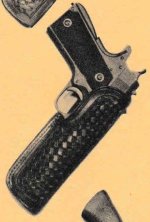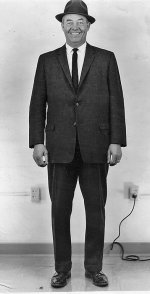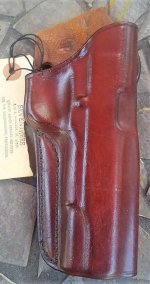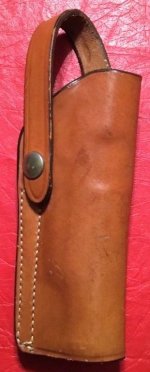Red Nichols,
What surprised me was that it wasn’t in the 76 or 81 catalogs.
I am shocked by the decline of safariland, because I remember them fondly
as a quality company. I was a target shooter back then, not much use for holsters in NRA 2700s.
Thank you for the information.
Fred
Ps that’s a very nice holster. Can you tell me more about donihoo
You are welcome to be shocked by the decline of Bianchi, too! They don't make a first quality piece of gunleather any more. And those bulky monstrosities that Safariland puts out don't deserve to be called holsters. The decline began with the company's acquisition (twice!) and transformation by one Warren Kanders at which point the company was happy to make stuff that makes money, vs holsters. I call the current operation Wakandiland; that's how little it resembles Neale's original firm.
Donihoo: he made more of a contribution than was realized before the research for Holstory was completed. Turned out was he, not JB, who conceived this holster that is erroneously called a Threepersons for the automatics:

This one is the Bianchi and from JB's earliest period (early '60s) as Protector Brand. It appears that the first one was by his mentor, Wally Wolfram also a Monrovia policeman whose experience dated from just after the War, in NM.

Donihoo the man himself

From an appearance in an early Protector Brand catalog

Seventrees actually made their own, and one for Donihoo to sell under his own name.

The best of the bunch (next to mine, of course, which is horsehide) is this vintage Becknell. Who was also a Texas lawman. Oliver Ball made a version, too, and he was also a Texas lawman.
Donihoo was an ex-G.I. and he joined Dallas P.D. out of the Army and his early newspaper appearances have headlines basically say 'cop shoots fleeing felon' over and over again. My favorite anecdote is that, according to same newspapers, he always knew how far away his target had been; because he would pace off the distance to the body from his pile of spent brass.
He lived 1912 to 1983 and it was in the late 1950s that he began to act as a sort of Johnny Appleseed, as had been done with the Brill before him precisely the year he was born, with his holster design. Lots of men became LEO's out of the military and their pistol, of course, was the 1911. Accomplices of mine including SG-688 and turnerriver have examples from Wolfram, Bianchi, Safari Ltd., Safariland, Seventrees, Ball, and Becknell; and of course from those who followed and/or copied (S&W and Colt were made by Wolfram); so from the entities that picked up after S&W Leathergoods, which was Gould & Goodrich and J.M. Bucheimer.
One reference indicates that Jack became a pariah in his P.D. because of his many kills; as being old-fashioned policing. He is notable for being part of the crime scene investigation (he had become a detective) at the JFK assassination in '63.
His version of what Bianchi called the No. 2, is distinctive because of its two rows of stitching at the welt. There was a purpose to it: unlike the single row with a backtack at the mouth of the welt, the Donihoo's double row provided stiffness to the internal welt (there were up to three, e.g., in a Becknell)(and zero, in a Seventrees). I do the same now that I understand the purpose but JB omitted them and switched from his early use of double welts (done to press on the dust cover for retention) in a strapless holster, to a single row with a safety strap.








